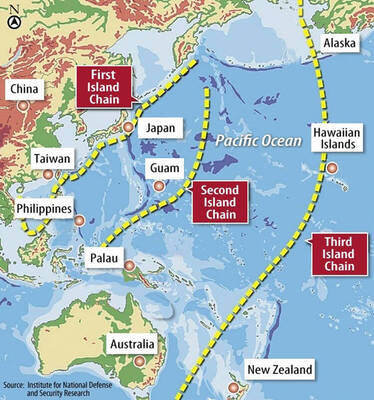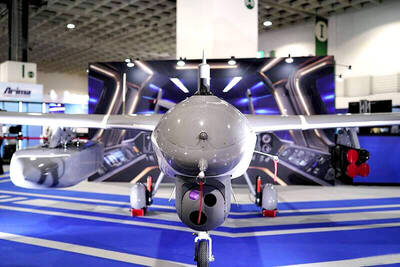Haute couture is all about dressing up — dressing way, way, up, in fact, in made-to-measure garments that cost as much as a new car. But Jean Paul Gaultier reversed the equation on Wednesday, sending out burlesque star Dita Von Teese, who peeled off layer after wildly expensive layer till she was stripped literally to the bone.
The campy strip show — which ended with Von Teese in a buff-colored bustier with sequin-covered applique bones mapping out her skeleton — was a fit finale to a fall-winter 2010-2011 collection largely about transparency and anatomy, with a dash of morbidness thrown in for good measure.
At Valentino, the garment’s anatomy — the bone-work that give the gowns their shape — took center stage, with translucent hoop skirts and an oblong birdcage made of tulle fitted over the bum-skimming mini-dresses.
Earlier in the week, Riccardo Tisci showed off the skill of the seamstresses at the house of Givenchy, delivering Mexican Day of the Dead-inspired lace and tulle bodysuits and gowns with appliques that mapped out the bones of the human body. In glimmering gold rhinestones and the finest Chantilly lace, his museum-quality concoctions were the world’s most expensive Halloween skeleton costumes.
On Aura Tout Vu’s fish-themed collection was meant for the thin slice on the Venn diagram where the very wealthy and very funny demographics overlap. After all, it takes a pretty good sense of humor to pull off an impeccable beige sheath dress with sleeves ending in stuffed fish-face hand puppets.
French veteran Franck Sorbier’s uplifting collection underscored the core values of couture — which is meant to be a celebration of creativity and technical savoir faire, but has increasingly become a media blitz used by luxury conglomerates for promoting aspirational secondary products like cosmetics, perfumes and sunglasses. Coming after big-budget mega-productions like Tuesday’s Chanel show, where models paraded beneath an enormous golden lion — in an homage to the founder’s astrological sign — Sorbier’s sincere and funny collection was a much-needed reminder of what couture should be about.
JEAN PAUL GAULTIER
The man who gave the world Madonna’s pointy bra went deeper in his exploration of the concept of underwear-as-outerwear with his anatomical collection of lean skirt suits and bustiers covered with rhinestone-encrusted femurs, tibias and ribs.
The porcelain-skinned burlesque star Dita Von Teese drove the audience wild with her mid-show strip tease, peeling off layer after layers of her black gown till she was wearing nothing but a bustier emblazoned with a twinkling applique skeleton.
“It was all about structure, about bringing the bones, the very foundation of what makes a garment, to the surface,” Gaultier told reporters in a post-show interview. “It’s about bones, but not in a ghost kind of way — unless we’re talking about the ghost of couture,” he joked.
Even the bride, who traditionally closes Paris’ made-to-measure couture collections, was wearing a trench coat — a Gaultier staple — in bone white mircofiber with a long tulle veil. And because this was Gaultier show — where a stiff dose of theatricality is de rigeur — the bride was playing her own wedding march — on a matching white violin.
RABIH KAYROUZ
Kayrouz flouted both convention and season, sending out barefoot models who, instead of careening down the runway in vertiginous heels, ambled barefoot over a catwalk covered in real grass wearing pleated silk tank-dresses for what was in theory a fall-winter show.
The audience of fashion editors, stylists and journalists — baking under the summer sun in courtyard — eyed Kayrouz’s fan-pleated silk dresses and airy, wide-legged trousers with undisguised envy. A knit tank-dress in chartreuse and a shirt-dress in bold teal looked particularly appealing to the melting crowd of fashion insiders.
Little green feathers, like a nascent layer of moss, emerged from the creases of the pleats that covered a putty-colored silk dress.
Belts in gold metal gave a hard edge to the gauzy knits and silks.
While other designers sent out more season-appropriate looks in leather with a sprinkling of fur, Kayrouz said he was seeking a middle route between couture’s ultra-exclusive looks made-to-measure for a handful of fabulously wealthy women and the off-the-rack designs most of us morals are condemned to wearing.
“Haute couture as we know it is almost something passe,” he said. “There’s no time for that. Now clients are very demanding and they want those well-designed, well-cut pieces in great materials, but they want them off the rack.”
VALENTINO
Valentino’s new design duo, who’ve been charged with the difficult task of rejuvenating the label’s aging customer base, had something for everyone — or, depending on how you look at it, nothing for anyone — with a collection that paired matronly chiffon blouses with the miniest of mini-dresses.
Designers Pier Paolo Piccioli and Maria Grazia Chiuri, who were promoted out of Valentino’s lucrative accessories division after the designer who briefly replaced founder Valentino Garavani was dismissed, have demonstrated their predilection for creeping hemlines in seasons past — to mixed reviews.
They gave it another shot, sending out pretty little bustier dresses that grazed the tops of the models’ gazelle thighs.
Sometimes the dresses, in black, beige, sea green and baby pink, were worn alone, sometimes layered over long-sleeved chiffon blouses that felt like they were channeling a 1970s schoolmarm.
It was a pretty collection, overall, but one that might prove a hard sell to the over-17 set, whose thighs no longer resemble those of a deer.

The US government has signed defense cooperation agreements with Japan and the Philippines to boost the deterrence capabilities of countries in the first island chain, a report by the National Security Bureau (NSB) showed. The main countries on the first island chain include the two nations and Taiwan. The bureau is to present the report at a meeting of the legislature’s Foreign Affairs and National Defense Committee tomorrow. The US military has deployed Typhon missile systems to Japan’s Yamaguchi Prefecture and Zambales province in the Philippines during their joint military exercises. It has also installed NMESIS anti-ship systems in Japan’s Okinawa

‘WIN-WIN’: The Philippines, and central and eastern European countries are important potential drone cooperation partners, Minister of Foreign Affairs Lin Chia-lung said Minister of Foreign Affairs Lin Chia-lung (林佳龍) in an interview published yesterday confirmed that there are joint ventures between Taiwan and Poland in the drone industry. Lin made the remark in an exclusive interview with the Chinese-language Liberty Times (the Taipei Times’ sister paper). The government-backed Taiwan Excellence Drone International Business Opportunities Alliance and the Polish Chamber of Unmanned Systems on Wednesday last week signed a memorandum of understanding in Poland to develop a “non-China” supply chain for drones and work together on key technologies. Asked if Taiwan prioritized Poland among central and eastern European countries in drone collaboration, Lin

NO CONFIDENCE MOTION? The premier said that being toppled by the legislature for defending the Constitution would be a democratic badge of honor for him Premier Cho Jung-tai (卓榮泰) yesterday announced that the Cabinet would not countersign the amendments to the local revenue-sharing law passed by the Legislative Yuan last month. Cho said the decision not to countersign the amendments to the Act Governing the Allocation of Government Revenues and Expenditures (財政收支劃分法) was made in accordance with the Constitution. “The decision aims to safeguard our Constitution,” he said. The Constitution stipulates the president shall, in accordance with law, promulgate laws and issue mandates with the countersignature of the head of the Executive Yuan, or with the countersignatures of both the head of the Executive Yuan and ministers or

CABINET APPROVAL: People seeking assisted reproduction must be assessed to determine whether they would be adequate parents, the planned changes say Proposed amendments to the Assisted Reproduction Act (人工生殖法) advanced yesterday by the Executive Yuan would grant married lesbian couples and single women access to legal assisted reproductive services. The proposed revisions are “based on the fundamental principle of respecting women’s reproductive autonomy,” Cabinet spokesperson Michelle Lee (李慧芝) quoted Vice Premier Cheng Li-chiun (鄭麗君), who presided over a Cabinet meeting earlier yesterday, as saying at the briefing. The draft amendment would be submitted to the legislature for review. The Ministry of Health and Welfare, which proposed the amendments, said that experts on children’s rights, gender equality, law and medicine attended cross-disciplinary meetings, adding that